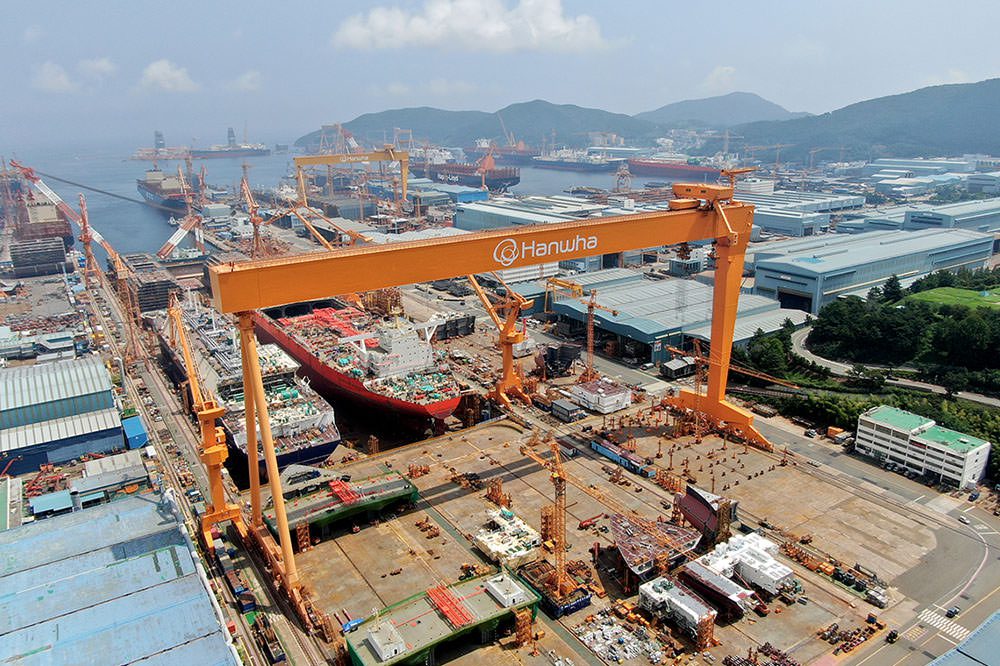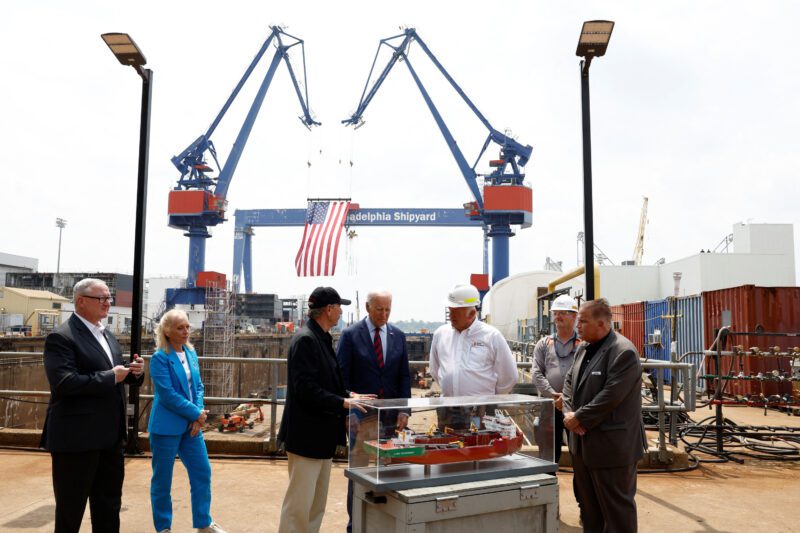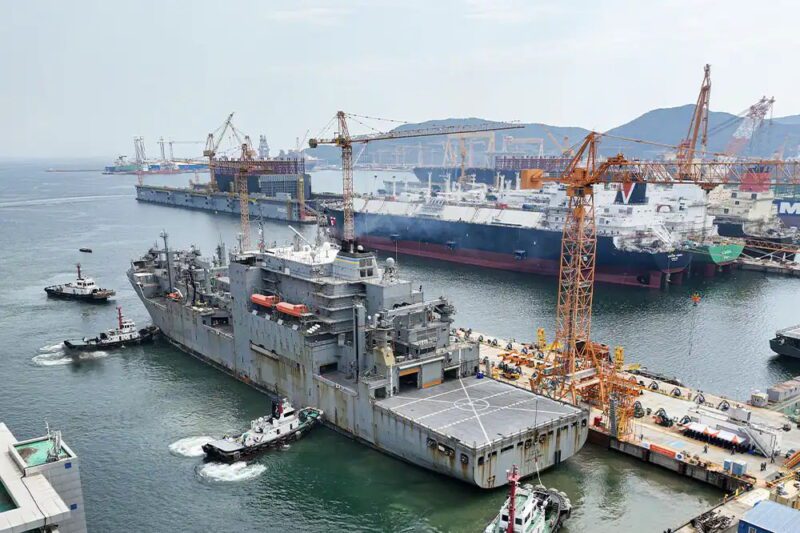Hung Cao – A Navy Diver In The Pentagon Briefing Room
Hung Cao and the Fight to Rebuild America’s Maritime Power Before the Next War Arrives by Captain John Konrad (gCaptain) The first thing you notice about the US Navy’s Undersecretary...

by John Konrad (gCaptain) At a defense expo in the Philippines, South Korea’s Hanwha Ocean unveiled its Ocean 4300 frigate, signaling more than just a new warship—it’s a direct challenge to China’s rapidly expanding naval power and a bold push into the global warship market. With Australia’s advanced CEAFAR-2L radar integrated into its design, the Ocean 4300 is primarily targeting regional buyers like the Philippines and Australia. But Hanwha is also making significant moves with the U.S. Navy, recently acquiring Philly Shipyard and securing its first contract to overhaul a U.S. Navy vessels overseas. As China ramps up warship production at breakneck speed, Hanwha is positioning itself not only to bolster South Korea’s naval capabilities but also to support the fleets of key allies, including the United States.
The Ocean 4300 frigate is based on South Korea’s proven Daegu-class (FFX Batch II) frigates, but with significant enhancements. According to reports from Naval News, the specifications are impressive. At 126 meters long, 15.8 meters wide, and displacing 4,300 tons, the ship is capable of reaching speeds up to 30 knots. Its hybrid CODLOG (Combined Diesel-Electric or Gas) propulsion system provides a range of 6,000 nautical miles at 15 knots, allowing for long-distance operations with a complement of 90 to 100 sailors.
The ship’s armament is designed for a range of missions, with a 32-cell Mk 41 Vertical Launch System (VLS) for surface-to-air and anti-submarine warfare missiles, as well as land-attack capabilities. It also features two quadruple anti-ship missile launchers, a 127mm main gun, Phalanx-type CIWS, and torpedo launchers. The flight deck and hangar can accommodate a Seahawk Romeo-class helicopter, enhancing its versatility in both defensive and offensive roles.
Vertical Launch System (VLS) cells are proving crucial in the Red Sea conflict. The United States Navy invested decades in developing two classes of Littoral Combat Ships, specifically designed to engage low to medium-capability adversaries near shorelines. However, the absence of VLS anti-air missiles and Phalanx-type Close-In Weapon Systems has largely sidelined these ships from the current fight against the Houthis.
VLS however, requires exception radar to find fast-moving missiles and drones. The Ocean 4300 has just that with the integration of Australian CEAFAR-2L radar, part of Australia’s advanced radar systems found on ANZAC-class frigates. This radar suite, though not explicitly named in the presentation, is recognizable by its signature panel configuration, providing robust S-, L-, and X-band coverage for enhanced situational awareness. The ship is also equipped with sonar systems, including hull-mounted and towed-array sonar for anti-submarine and anti-autonomous underwater vehicle (AUV) operations.
South Korea’s shipbuilding industry has long been a global leader, renowned for producing both commercial and military vessels. However, it is now facing stiff competition from China, which has rapidly expanded its shipbuilding capabilities. China has leveraged its vast commercial shipyard capacity to produce naval warships at an unprecedented pace, a move that has shifted the regional power balance.
While South Korea excels in high-tech, advanced designs like the Ocean 4300, China’s ability to mass-produce warships, including frigates and destroyers, is reshaping the naval market. Chinese shipyards, often backed by significant state support, can pump out naval vessels quickly and at scale, offering countries looking to modernize their fleets a cost-effective and fast solution. The question is can Hanwa Ocean ramp up warship fast enough and at a reasonable enough cost for allies to match the People’s Liberation Army Navy’s rapid growth?

In addition to new ship designs, Hanwha Ocean is positioning itself as a key player in helping address the U.S. Navy’s shipbuilding shortfall. While the U.S. struggles with delays and cost overruns, not to mention potential sabotage, in American shipyards, U.S. Secretary of the Navy Carlos Del Toro is looking to allies in Asia – whose shipbuilders are more efficient and capable of producing both commercial and military vessels – to invest in America.
Hanwha Ocean has taken significant steps to enter the U.S. market, acquiring the Philly Shipyard and securing its first-ever contract to overhaul a U.S. naval vessel. This acquisition could mark the start of deeper South Korean involvement in revitalizing America’s ailing shipbuilding sector. While China’s ability to produce warships at scale gives it a strategic advantage, South Korea’s expertise in advanced shipbuilding technology and culture of efficiency may help the U.S. keep pace in the race to modernize its naval fleet.
It’s too early to tell if the Ocean 4300 will one day be built in American yards or if newly acquired shipyards like Philly will build American-designed frigates. This could be an important distinction considering a recent congressional audit revealed that the U.S. Navy mishandled oversight of its $22 billion US Navy Constellation class frigate program, intended to replace the troubled Littoral Combat Ship. That frigate was originally based on a European design but large numbers of change orders led to increased weight and potential subsystem failures. The report criticized the Navy’s inadequate review processes, which led to premature construction. The program is now facing serious delays, with the first frigate expected three years behind schedule and costs rising to over $1.3 billion per ship.
Hanwha’s investment in Philly is part of a broader Maritime Statecraft effort by the U.S. to work closer with allies and attract foreign shipbuilders to bridge its industrial gap, a critical move as maritime power plays an increasingly central role in national security. However, rebuilding America’s shipbuilding capabilities will take time and substantial investment. Hanwha’s move into the U.S. market is a crucial step in this long-term strategy but will they be able to ramp up production fast enough to match China?

As if new investment in American shipyards and new frigate designs announced at home were not enough Hanwha is also pushing hard into the warship repair market to help the US Navy address ship repair backlogs.
Early this month Hanwha Ocean announced wining a bid to provide maintenance, repair, and overhaul (MRO) services for the USNS Wally Schirra, a 40,000-ton U.S. Navy dry cargo and ammunition ship. This project marked the first time a Korean shipbuilder will provide Maintenance, Repair and Overhaul (MRO) services for the U.S. Navy.
The ship is undergoing maintenance and inspection at Hanwha Ocean’s Geoje shipyard, with additional onshore maintenance work being conducted using the shipyard’s floating facilities. The three-month project is expected to expand Hanwha Ocean’s global defense activities by showcasing its advanced technology and maintenance infrastructure to the U.S. Navy.
“With the global naval vessels MRO market size projected to exceed $60 billion annually, this U.S. Navy maintenance project represents a stepping stone to a significant leap forward,” said a spokesperson for Hanwha Ocean. “We have meticulously prepared and refined our MRO services to build trust with the U.S. Navy. We will also work closely with local small and medium-sized enterprises to support the maintenance industry in South Korea.”
The unveiling of the Ocean 4300 isn’t just about showcasing a new frigate — it represents South Korea’s broader strategy to stay competitive in the global naval marketplace. By integrating Australian radar technology and offering a highly capable, multi-role frigate, Hanwha Ocean is positioning itself to meet the growing demand for naval modernization across the Indo-Pacific.
Since 1973, the company – previously known as Daewoo – has pioneered new businesses, boasting the production of some of the world’s most competitive LNG carriers built with eco-friendly and highly efficient technology. They’ve produced a vast range of vessels, including commercial ships, drillships, and specialty ships. The question is: Can they translate this success to the warship market and shipyards in America?
In a region where naval power is becoming increasingly central to national security, South Korea’s Ocean 4300 frigate could play a pivotal role in shaping the future of Indo-Pacific naval forces.
Related Article: Hanwha Abandons Austal Takeover Bid Amid Due Diligence Dispute

Sign up for gCaptain’s newsletter and never miss an update

Subscribe to gCaptain Daily and stay informed with the latest global maritime and offshore news
Essential news coupled with the finest maritime content sourced from across the globe.
Sign Up